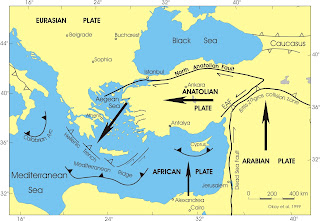Volcanoes in Turkey

How do Volcanoes Work? Before we begin discussing volcanoes, here is a short video clip with Dr. Liz Cottrell, of the Smithsonian Institution's National Museum of Natural History. She talks about what causes a volcano to erupt and demonstrates the principle behind the eruption: https://www.youtube.com/watch?v=6BGd79g1tms Turkey: Rich in Volcanoes Turkey ranked 14th, in an assessment of overall volcanic threat, out of 95 volcanically active countries, reflecting high population exposure. T urkey is vulnerable to volcanic hazards due to the large exposed population, lack of experience of public officials and communities with volcanic emergencies, very limited volcano monitoring, and lack of knowledge on volcanic hazards and risk. Examples of different types of volcanoes in Turkey Mt. Ararat – Stratovolcano Last eruption – 1840 CE The 5165-m-high, double-peaked stratovolcano Mount Ararat, also known as Agri Dagi, is ...


